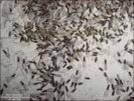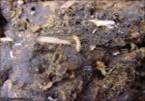Termites
Termites are social insects that eat wood. There are two basic types of termites, those that live entirely in wood (Drywood & Formosan) , and those that can tunnel into the ground (Subterranean).
Most termites are the subterranean type and are able to tunnel in the soil. The ability to tunnel allows them to find many separate pieces of wood, on which to feed. Since they are not limited to one piece of wood, their colonies can be much bigger than those of wood-inhabiting species. Usually their colonies number from hundreds of thousands to several million. The mother of the colony is usually quite grossly pregnant. These mothers are the mothers of all mothers, so to speak. Hence, they are called queens. The soil-tunnelling termites have a more advanced caste system with true workers. True workers are never able to become alates although they can become soldiers and sometimes they even transform into special reproductives called ergatoids. Soldiers of subterranean termites have a gland on the head that secretes defensive chemicals. The soldier jaws are modified in many weird and wonderful ways; they may be sword-like, serrated, toothed, hooked, rod-like, etc. Some soldiers have extraordinary snapping mandibles. In another group, the mandibles are regressed to tiny points while the defensive gland is produced forward as a nose; these are the nasute termites. Many subterranean termites have specialized diets and may eat plant litter, grass, dung or humus, instead of wood. In tropical areas many subterranean termites build nests or mounds which are among the most impressive examples of animal architecture.
"I suspect that my home may have termites. How can I tell if I have a termite infestation and what are the signs of damage associated with termites?"Termites feed on cellulose in wood and paper products such as books, cardboard, and various other items. Termite damage in homes is usually not obvious until significant damage has occurred. Sometimes homeowners first notice termites when they swarm. Swarmers are "winged reproductives" that leave the colony in a swarm to mate, reproduce, and start new colonies. Yet, it's the worker termites - small, creamy white insects that are seldom seen -- that are the most numerous and the cause most of all the termite damage. There are many species of termites that can infest homes under a variety of conditions.



Subterranean termites, the most common type, build nests in the ground and often construct mud tubes on structures. They use the mud tubes as passageways to explore for food and travel to and from the soil. If you suspect that you have a termite infestation, you should have your home thoroughly inspected by a termite specialist. Professional termite inspectors are trained to locate specific areas in your home where a termite attack is most likely to occur. If termites are found, the specialist can design a treatment plan to control current infestations and to protect your home from future infestations.How Termites Enter The Home The most common termite, the subterranean, builds its nest in the ground. These termites construct mud tubes which are used to explore for food and connect their underground nest to that food source. They can enter a building without direct wood contact with the soil through such tubes. Termites can enter buildings through cracks, expansion joints, hollow bricks or concrete blocks around plumbing. They can find their way into a structure through an opening as small as 1/32 of an inch. Any building, whether constructed with slab, basement or crawl space foundations, can be targets for termite infestation."I don't have a termite problem in my house now and I want to make sure I don't get one in the future. What can I do to make my home less susceptible to termites?"There are several things you can do to help make your home less susceptible to termites: · Look for excessive moisture in and around your home especially in basements and crawl spaces. Termites require moisture to successfully live and breed in structures. Reducing moisture problems in and around your home will decrease the likelihood of termite attack. Repair leaking pipes, water lines and fixtures that may wet any wooden parts of your home. · Stack firewood, lumber and other wooden items several feet away from your home and plant flowerbeds and other frequently watered ornamentals as far away from the perimeter of your house as possible. · Ideally, wood-containing mulches should be placed at least one foot away from the foundation of your home. Wood used in decks and porches should be pressure treated. · Outdoor lights with white bulbs may attract night swarming termites, especially in the spring. Try replacing white bulbs with yellow or pale amber. Commonly Asked Questions About Termite Treatment • What is a termiticide? It is a type of chemical used for the control of termites. Each is extensively tested for effectiveness by the U.S. Forest Service and registered by the Environmental Protection Agency (EPA). • Will the wood in my home be treated? Direct treatment of the wood is seldom done since the soil application procedure will eliminate the majority of subterranean termite problems. If required, there are special products available to the professional to effectively remove termites from the wood. • Will there be an odor? There might be a slight odor from the treatment but it should only last a short period of time. • Are termiticides a danger to my health? Studies show that when termiticides are applied according to label directions no adverse health effects occur to persons applying the product or to occupants of the treated building.






